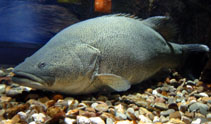| Family: |
Percichthyidae (Temperate perches) |
| Max. size: |
180 cm SL (male/unsexed); max.weight: 114 kg; max. reported age: 48 years |
| Environment: |
demersal; freshwater; depth range - 5 m, potamodromous |
| Distribution: |
Oceania: throughout most of the Murray-Darling River system of South Australia, Victoria, New South Wales, and Queensland, except for the upper reaches of the southern tributaries (Ref. 6390). Introduced into many lakes and dams throughout Victoria and New South Wales. Their abundance has been drastically reduced across their natural range and they are now considered rare in many Victorian tributaries (Ref. 27498). |
| Diagnosis: |
|
| Biology: |
The Murray cod is one of the world's largest freshwater fish (Ref. 6390). They live in a wide range of habitats, from clear, rocky streams to slow flowing, turbid rivers and billabongs (Ref. 27498). They are generally found in waters to 5 m deep, in sheltered areas with cover from rocks, timber or overhanging banks. Adult fish are carnivorous, having a diet of invertebrates, fish, amphibians and occasionally reptiles, birds and aquatic mammals (Ref. 27498). The young feed on zooplankton. Spawning takes place from spring to early summer. Murray cod are territorial, their 'territory' associated with a specific hole, snag (large woody debris) or area of a river or lake (Ref. 27498). Juveniles may undertake migrations (Ref. 6390). Threatened due to over harvesting and habitat loss (Ref. 58490). |
| IUCN Red List Status: |
Least Concern (LC); Date assessed: 13 February 2019 Ref. (130435)
|
| Threat to humans: |
harmless |
Source and more info: www.fishbase.org. For personal, classroom, and other internal use only. Not for publication.

